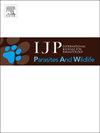小鱼蛾的“诱饵捕鱼”策略:摄食行为介导的黑鲷幼鱼侵染
IF 2
3区 医学
Q3 ECOLOGY
International Journal for Parasitology-Parasites and Wildlife
Pub Date : 2025-04-01
DOI:10.1016/j.ijppaw.2025.101057
引用次数: 0
摘要
水蛭科,1818(等足纲)是寄生的甲壳类动物,寄生于海洋、咸淡水和淡水环境中的鱼类。很少有研究调查孢子虫科用来寄生宿主的策略。在本研究中,我们验证了Mothocya parvostis Bruce, 1986(等足目:纤毛虫科)利用寄主的摄食行为来寄生寄主的假设。在我们的侵染实验中,在有和没有施莱格利亚蒿(1819)(施莱格利亚蒿饲料)nauplii的水箱中,施莱格利亚棘海鲷(Bleeker, 1854)幼鱼被mancam . parvostis侵染。结果表明,100只施勒格莱拟蚊幼虫中有46只被寄生,其中36只在试图吞食曼卡时被寄生。青蒿的存在使侵染率显著降低,侵染时间延长。这可能是由于青蒿的存在转移了施勒格莱拟虫幼虫的注意力,减少了它们对鬃毛的摄食。小蛾虫利用宿主的摄食行为来增加其入侵的成功率,类似于“诱饵捕鱼”,这可能有助于保持其在宿主中的高流行率。本文章由计算机程序翻译,如有差异,请以英文原文为准。

“Lure fishing” strategies by Mothocya parvostis (Isopoda: Cymothoidae): Feeding behavior-mediated infestation on juveniles of black sea bream, Acanthopagrus schlegelii
Cymothoidae Leach, 1818 (Isopoda) are parasitic crustaceans that infest fish inhabiting marine, brackish, and freshwater environments. Few studies have examined the strategies Cymothoidae use to parasitize their hosts. In this study, we tested the hypothesis that Mothocya parvostis Bruce, 1986 (Isopoda: Cymothoidae) parasitizes its hosts by exploiting its feeding behavior. In our infestation experiments, juveniles of the black sea bream Acanthopagrus schlegelii (Bleeker, 1854) were infested with M. parvostis mancae in water tanks with and without nauplii of Artemia Leach (1819) (A. schlegelii feed). Overall, 46 of 100 A. schlegelii juveniles were parasitized, 36 of which were parasitized when they attempted to consume the mancae. The presence of Artemia resulted in a significantly lower infestation prevalence and a longer time to infestation. This may be attributed to the presence of Artemia diverting the attention of A. schlegelii juveniles and reducing their feeding on mancae. Mothocya parvostis exploits the feeding behavior of its host to increase its infestation success, similar to “lure fishing,” which may help maintain its high prevalence in hosts.
求助全文
通过发布文献求助,成功后即可免费获取论文全文。
去求助
来源期刊

International Journal for Parasitology-Parasites and Wildlife
Medicine-Infectious Diseases
CiteScore
3.80
自引率
5.60%
发文量
113
审稿时长
45 days
期刊介绍:
The International Journal for Parasitology: Parasites and Wildlife (IJP-PAW) publishes the results of original research on parasites of all wildlife, invertebrate and vertebrate. This includes free-ranging, wild populations, as well as captive wildlife, semi-domesticated species (e.g. reindeer) and farmed populations of recently domesticated or wild-captured species (e.g. cultured fishes). Articles on all aspects of wildlife parasitology are welcomed including taxonomy, biodiversity and distribution, ecology and epidemiology, population biology and host-parasite relationships. The impact of parasites on the health and conservation of wildlife is seen as an important area covered by the journal especially the potential role of environmental factors, for example climate. Also important to the journal is ''one health'' and the nature of interactions between wildlife, people and domestic animals, including disease emergence and zoonoses.
 求助内容:
求助内容: 应助结果提醒方式:
应助结果提醒方式:


